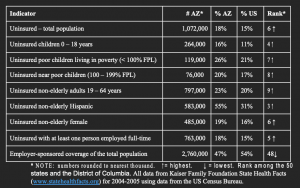ARIZONA PUBLIC HEALTH ASSOCIATION RESOLUTION DOCUMENTATION FORM
Date Submitted: 7/7/05 Name of Submitted by: Charlotte Harrison
charrison@azfpc.org
Date Revised:
Title of Resolution: Pharmacies and Pharmacists – Duty to Fill Prescriptions
1. Statement of the Problem
This year, legislation passed in the Arizona Legislature that would have allowed pharmacists to refuse to fill prescriptions for emergency contraception based on his/her own personal religious or moral beliefs. The governor vetoed the bill, but it is not unlikely that such legislation will be introduced again. Such legislation would restrict women’s access to emergency contraception, especially in rural areas. Emergency contraception prevents an unplanned pregnancy, is approved by the FDA and is only available when prescribed by a licensed clinician.
2. Statement of Desired Action
The Arizona Public Health Association will take a public and vocal stand against restricting access to emergency contraception by allowing pharmacists not to fill a prescription unless a referral is made that would make EC immediately available.
3. Which other groups or organizations support this effort?
The Family Planning Coalition of Arizona. Membership include representatives from Arizona Family Planning Council, AzPHA, NOW, League of Women Voters, Planned Parenthood of Central and Northern Arizona, Planned Parenthood of Southern Arizona, some counties and others. The American Medical Association recently passed a resolution to require pharmacists to fill all prescriptions or provide immediate referrals.
4. Describe relationship of this issue to the current AzPHA Legislative Priorities.
AzPHA has a longstanding history of supporting access to family planning services.
5. Is this an issue for legislation?
The task will be to defeat any proposed legislation that allows pharmacists to refuse filling a legally written prescription.
6. Brief Financial and Public Health Analysis.
Emergency contraception (the morning after pill, Plan B) is a concentrated dose of oral contraception (birth control pills) that prevents a pregnancy. It is not an abortifacient, not to be confused with RU-486. Emergency contraception will not work if the woman is already pregnant. Planning and spacing pregnancies increases the chances of a healthy pregnancy and the birth of a healthy baby. Currently AHCCCS pays for 50% of all deliveries in the state, a portion of which is a result of an unplanned pregnancies.
PROPOSED AZPHA RESOLUTION
PHARMACIES AND PHARMACISTS – DUTY TO FILL PRECRIPTIONS
September 2005
In 2005, legislation passed in the Arizona Legislature that would have allowed pharmacists to refuse to fill prescriptions for emergency contraception based on his/her own personal religious or moral beliefs. The governor vetoed the bill, but it is not unlikely that such legislation will be introduced again. Such legislation would restrict women’s access to emergency contraception, especially in rural areas. Emergency contraception prevents an unplanned pregnancy, is approved by the FDA and is only available when prescribed by a licensed clinician.
Emergency contraception (the morning after pill, Plan B) is a concentrated dose of oral contraception (birth control pills) that prevents a pregnancy. It is not an abortifacient, not to be confused with RU-486. Emergency contraception will not work if the woman is already pregnant. Planning and spacing pregnancies increases the chances of a healthy pregnancy and the birth of a healthy baby. Currently AHCCCS pays for 50% of all deliveries in the state, a portion of which is a result of an unplanned pregnancies.
Refusal by a pharmacist to fill a legally written prescription for emergency contraception
discriminates against women who are the only users of this contraceptive,
creates additional barriers for women in rural areas where pharmacies are scarce,
allows the personal belief of a pharmacist to override medical treatment directives of a physician and the desires of the patient.
jeopardizes a rape victim’s ability to avoid an unwanted pregnancy.
Therefore Be It Resolved that the Arizona Public Health Association:
Oppose any proposed legislation intended to restrict access to emergency contraception by a pharmacists unless immediate alternative access without unnecessary delay or interference is provided.
Support any proposed legislation which requires individual pharmacists or pharmacy chains to fill legally written prescriptions or to provide immediate alternative access without unnecessary delay or interference.
142~2005_(1) Duty to Fill Prescription (medications, reproductive health, rural, healthcare)
